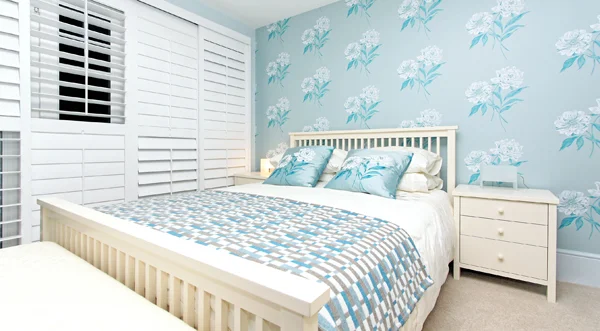Homeowners’ love of wood extends to their choice of window coverings.
By Diane Franklin
One of the biggest trends in home decorating—both inside and out—is the use of natural wood. Homeowners love the look of wood for outside decks, exterior trim, interior floors, moldings, baseboards—you name it. So, it should come as no surprise that the look of wood is also a desirable trend at the window.
There are several ways to use the look of wood in window treatments, including wood blinds, faux wood blinds, interior shutters and woven wood shades. Here’s a description of each of those options.
Wood Blinds
Wood blinds are a fashionable and functional choice for the window. They offer the easy operation of traditional horizontal blinds with the added beauty of natural wood grain.
Colour choices for wood blinds range from light hues like golden oak and pine to deep hues like chestnut and mahogany. You can also get these real wood blinds painted in whites, off-whites and blacks, discernable from vinyl or metal blinds because you can still see a visible wood grain. Based on this colour variety and such fashion embellishments as cloth tapes and valances, wood blinds will work well in virtually any type of decorating style, from traditional to contemporary.
The most popular slat sizes for wood blinds are 2-inch or 2½-inch widths. They have a better profile in those sizes than in 1-inch slats, and anything wider than 2½ inches would make the blind too heavy. Even in a 2- or 2½-inch width, wood blinds are heavier than other window covering options, so take that into consideration when determining whether this is the best choice for a large window.
Also be aware that wood slats are thicker than slats made from other materials. This will cause a greater stack at the top of the window when the blinds are open. You may wish to use a deep cornice or window topper to hide the stack. Or if you prefer a fuller view at the top of the window, faux wood blinds might be a better option.
Also because wood is susceptible to water damage, your best bet is to avoid using wood blinds in areas where they could come into contact with water, such as bathrooms or over kitchen sinks.
Faux Wood Blinds
Faux wood blinds offer the same fashion advantages as wood blinds—the look of wood grain—but they typically are made of a vinyl/PVC or composite wood material. They’re cheaper and also lighter weight, which makes them easier to operate and maintain than real wood blinds. You also can use faux wood blinds on wider windows without worrying about the weight.
As previously mentioned, you won’t have the problem of a thicker stack at the top of the window obstructing your view, which is one of the downsides of using real wood blinds.
One additional advantage of faux wood blinds—since they’re not real wood, you won’t have to worry about water damage, meaning they are perfectly suitable for bathroom settings and anywhere in your kitchen.
Interior Shutters
Interior shutters are increasing in popularity. They are sleek, sophisticated, easy to operate and easy to maintain. Typically interior shutters come in white because that provides an ultra-clean look, but homeowners can choose other colours to complement the rest of their décor.
Plantation shutters are the most popular type of interior shutters. The louvers are typically 2½ to 4½ inches wide (in contrast to traditional shutters, which have louvers of approximately 1¼ inches in width). The shutters can be opened up completely for a less obstructed view or closed tightly for light and heat control as well as privacy.
Interior shutters come in actual wood but also are available in vinyl, vinyl-clad wood or composite. Wood is the most expensive option, but also the most versatile. Wood shutters come in a wider variety of shapes and sizes than vinyl or composites. They also can be painted, stained or refinished to match your home’s décor.
Keep in mind that wood shutters are susceptible to the same moisture issues as wood blinds. Thus, you won’t want to use them in areas of your home where water or humidity is an issue.
Woven Wood Shades
Woven wood shades are having a resurgence thanks to their eco-friendly qualities. Woven woods use natural materials such as bamboo, jutes, reeds and grasses to provide a casual, earthy appearance, which fits in well with rustic décors. Colours are typically earthy and neutral, allowing them to coordinate well with virtually any colour scheme.
All of these window covering choices have one thing in common—they provide warmth, beauty, functionality and a connection to nature that raises the eco-friendly appeal of your home.

